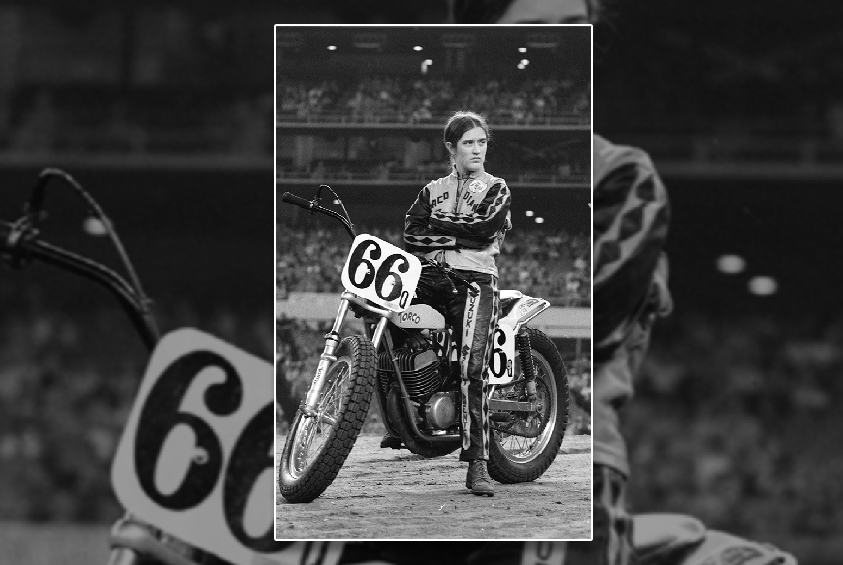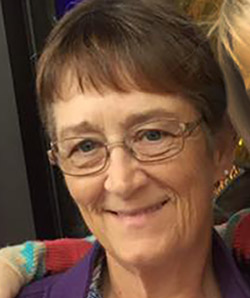AMERICAN MOTORCYCLIST April 2019
Riding It To The Max
First Female Expert: Diane Cox

Diane Cox the day she made history as the first woman to qualify for an AMA GNC event.
By Greg Pearson
“You Rode it to the max, Diane!” exclaimed a track worker at the Fall San Jose Mile in 1976, as he hustled to help downed racer, 19-year old Diane Cox to her feet.
Cox had low-sided Gary Scott’s loaner XR750, in a last-lap, last-corner bid to beat Pee Wee Gleason in the Trophy Dash. It was an exciting end to the race. It was also a turning point for the first female pro dirt track motorcycle racer in this country.
Cox, from Salem, Ore., became the first female racer to earn an AMA Expert dirt track license. It seemed like a big deal back in 1975. In fact, it seems like a big deal now. Yet, to Cox, it wasn’t a major accomplishment.
“It was fun … just something I did,” she said.
Cox said she rode and raced because many of her friends did. They were caught up in the motorcycle boom of the late 1960s. Cox ’s stomping ground around Salem produced many AMA racers, such as Billy Oliver, Chuck Joyner, Randy Skiver and Mark Williams.
Cox’s dad, Richard, was a bike fan and “always” had street bikes. She recalls that her dad even raced some local stuff, “a muddy oval at the fairgrounds.”
He later bought Cox and her sisters a Honda 50 step-through. Diane took to the bike quicker than her siblings, and her dad encouraged her to race.
Racing with the guys was the best training ground for young Cox. She more than held her own on a Suzuki A100, scoring wins.
 “I should have probably waited until the front straight to make a move, but I went into the corner way too hard and had to go for it.”
“I should have probably waited until the front straight to make a move, but I went into the corner way too hard and had to go for it.”
One of Cox’s favorite periods was just before she turned pro, around 1971-72. By then a locally well-known, seasoned racer, she competed at the top of the lightweight ranks throughout the Pacific Northwest’s ovals and TT tracks.
A night that stands out was at Bend, Ore., when she won all three classes she entered, on 100 and 125 Suzukis and a Bultaco. Cox remembers with fondness that “I won like $105, and we all went out to eat and blew all the money!”
In 1973, Cox turned 16 and she and her dad talked about turning pro.“It was just the natural thing to do,” she said.
Riding a 250 Suzuki, Cox didn’t miss a beat in her Novice year, riding the bigger half-miles. Strong finishes quickly netted the necessary 40 points to advance to the next rung on the ladder, the Junior division.
In her Junior year, Cox raced mostly TT tracks close to home. She rolled up points toward the magic number of 80 that would advance her to the Expert division.
As the end of the season neared, she was a couple points shy. The team journeyed nearly 1,000 miles to Ascot, Calif., where Cox scored the needed points.
She finished sixth in Junior TT points in the Professional Riders Competition Final Points. She also finished 10th in the Pacific Region in the Final Junior Regional point standings.
In 1975, Cox became an AMA Expert dirt track racer. She made her Expert debut at the Houston Astrodome opener for the Grand National Championship series. Although she didn’t qualify for the TT, at the next night’s Houston Grand National Short Track, she made history as the first woman to qualify for an AMA GNC event, qualifying 48th out of 136 entrants.
The Trophy Race at the 1976 Fall San Jose Mile was probably the greatest racing story of Cox’s career.
Struggling with a very fast new ride, she battled hard with Pee Wee Gleason, Vern Johnson, Jay Ridgeway and others on a tricky, slippery track. She fought her way forward, then dropped back as Gleason surged to the lead.
Cox then made a charge, tearing through the pack. She was catching Gleason but in the last turn of the last lap, she hit a slick spot and suddenly went down.
In retrospect, Cox said, “I should have probably waited until the front straight to make a move, but I went into the corner way too hard and had to go for it.”
Then came a turning point in Cox’s career. She had proved she could go fast and had GNC potential, but she realized that continuing at this level meant getting an expensive Harley-Davidson XR750 and sponsors.
Her San Jose ride garnered attention from major motorcycle magazines, and Cox had interviews in Cycle News, Motorcycle Weekly and Dirt Bike. She was popular with the fans. Unfortunately, none of that translated to sponsorship money.
During the 1970s, the fight for women’s equality was still an open, often controversial, issue. The “debate” spawned a popular nationwide TV show called, the “Battle of the Sexes,” that pitted men and women against each other.
Cox appeared on the show in 1977 and 1978. The show featured best two-out-of-three match races at Ascot Park. The first time was with former GNC champ Gene Romero; the second with then-current champ Jay Springsteen.
In 1977, Kawasaki Motor Co. selected Cox and 16 other racing stars to set 750cc endurance records with their new KZ650 at Daytona International Speedway.
She said the only trouble she had was her helmet kept getting pulled back by the wind blast, and she rode most of the time holding her helmet with one hand. In the end, she said, it was fun.
Besides her airfare, she got $400 plus a bonus for being the most consistent rider. In the end, the riders broke eight AMA and FIM world records at various distances and hours, up to the 24-hour mark.
Cox also was one of 30 racers—including Malcom Smith, Kent Howerton, Bob Hannah, Jim Rice and others—to compete in the first International Motorcycle Olympiad (which later became the Superbikers series, and led to Supermoto) at Saddleback Park in California in 1977.
In 1978, Cox quietly retired from professional competition. She successfully resumed road racing in club events at PIR and Seattle International Raceway, riding the same stock TT500 she used at the Olympiad.
All in all, Cox doesn’t view her pro racing career as a big deal.
It was just something that came naturally. She did it because she enjoyed it. When it stopped being fun, she quit. Simple as that.
She said her favorite memories are going to those little races around her hometown with family and friends.
Greg Pearson is a motorsports writer and historian.
